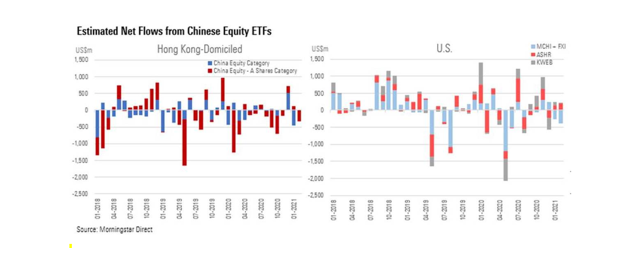The net-sales trend has maintained the trajectory seen last year and corresponds to a similar shift out of US-listed ETFs with broad China equity exposure, the research firm’s data shows.
Outflows have been most pronounced in A-share linked ETFs, despite the strong performance of Chinese onshore equities in 2020, with the MSCI China A index posting a 43.5% return for the calendar year, according to FE Fundinfo.
The index was up 4.1% in the first two months of this year but began a fall in mid-February amid concerns of high valuations for racy growth stocks, which has since developed into a rout.
There were net outflows of $330m in February, coming mainly from the iShares FTSE A50 China ETF and the CSOP FTSE China A50 ETF, which recorded net outflows Morningstar estimates at $130m and $99m, respectively.
Hong Kong-domiciled ETFs invested in offshore China equities fared better last month, noted Jackie Choy, director of exchange-traded fund research for Morningstar.
There were small net inflows of $12m, but net inflows from the Global X China Electric Vehicle ETF, estimated at $105m, were partly offset by net outflows of $75m from the Hang Seng China Enterprises Index ETF.
There are 45 Hong Kong-domiciled ETFs that track either onshore or offshore Chinese equities, with an aggregate AUM of about $13.9bn, according to Morningstar data. It is a dominant segment of the Hong Kong ETF market, which in total comprises 128 ETF issues worth $42.1bn, the data shows.
The largest individual Chinese equity-linked ETFs are the $3.4bn Hang Seng China Enterprises ETF (whose composition will likely be re-shaped by the changes planned for the index by Hang Seng), the $2.5bn iShares FTSE A50 China ETF, and the $2.4bn China AMC CSI 300 ETF.
Despite recent set-backs, asset managers still expect demand for China equity-linked ETFs. This week, for instance, Harvest Global Investments listed its first ESG ETF in Hong Kong.
OUTFLOWS FROM US-LISTED FUNDS
Among US-listed ETFs the relative popularity of onshore and offshore China equities was reversed.
Morningstar estimates that there were net outflows of $400m from the iShares China Large-Cap ETF and the iShares MSCI China ETF, two of the largest ETFs that track offshore Chinese equities. But in contrast, there were net inflows of $200m into the Xtrackers Harvest CSI 300 China A ETF.
Looking at activity in 2020, Choy notes that Hong Kong-domiciled China offshore ETFs suffered net outflows of $300m and A-share tracking ETFs listed in the SAR saw outflows of as much as $2.6bn. All three of the largest funds listed in Hong Kong experienced net sales.
Meanwhile, the two largest ETFs by AUM offering broad Chinese offshore equity exposure listed in the US – the iShares China Large-Cap ETF and the iShares MSCI China ETF –experienced net outflows amounting to around$200m.
The biggest ETF by AUM with broad Chinese onshore equity exposure, Xtrackers Harvest CSI 300 China A ETF (ASHR), had net outflows of around $70m, while another well-traded ETF, the KraneShares CSI China Internet ETF garnered net inflows of $600m, according to Choy.


















